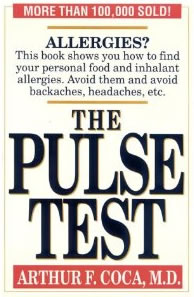The Pulse Test
 All too often we think of allergy in terms of notable reaction; perhaps some food or substance that gives you a rash or causes itching or swelling, maybe even anaphylactic shock? Yes, those are certainly note worthy allergies. But there are many sub-acute, or metabolic allergies that you may not be aware of. These allergies will not cause symptoms associated as a “reaction” but they are causing all kinds of health interference. There are many kinds of allergy tests available. Some use a skin scratch test, some are tested against your blood proteins, and there are many people doing some sort of kinesiology based allergy test. But there is a perfectly accurate allergy test you can do AT HOME, called The Pulse Test.
All too often we think of allergy in terms of notable reaction; perhaps some food or substance that gives you a rash or causes itching or swelling, maybe even anaphylactic shock? Yes, those are certainly note worthy allergies. But there are many sub-acute, or metabolic allergies that you may not be aware of. These allergies will not cause symptoms associated as a “reaction” but they are causing all kinds of health interference. There are many kinds of allergy tests available. Some use a skin scratch test, some are tested against your blood proteins, and there are many people doing some sort of kinesiology based allergy test. But there is a perfectly accurate allergy test you can do AT HOME, called The Pulse Test.
Did you know that a sub-acute allergy can be the trigger behind that nagging health condition that nobody seems able to fix? An allergy can trigger emotions and feelings that you seem unable to control, including depression. These sub-acute allergies can even be what is keeping you from losing the weight you want even though you are exercising and “dieting.” Any time I have a client where the normal treatment protocols do not seem to be making a difference, I suspect a sub-acute allergy. But maybe you don’t suffer any of those problems, what about the cellular stress and oxygenation secretly causing you to age? Does that bother you?
An allergen is defined as any substance that causes an overcompensation of the body’s immune system. An allergy occurs when the body cannot digest, metabolize or otherwise “deal with” that particular substance. It may be a food, beverage, something coming into contact with your skin, something you breathe in, even a thought! What happens when you think about something stressful? Your pulse goes up. Well, you may not have noticed, but anytime you ingest or come into contact with something your body cannot digest, metabolize or otherwise “deal with,”, your pulse goes up, and that, is a sub-acute allergy.
Dr. Arthur F. Coca (1875-1959) was an expert in allergies and highly respected in his field until he discovered the pulse test and consequently was asked to leave Columbia University. His wife was a medical researcher who was admitted to the hospital with severe heart palpitation. She was treated with morphine and consequently her pulse went up to more than 180 beats per minute. This was how Dr. Coca discovered the connection between substances and the pulse. He researched this phenomenon and wrote “The Pulse Test”, which is still in print. The Pulse Test is an easy way to determine the effect of any substance you are exposed to.
How to perform the Pulse Test (please note that smoking may inhibit a correct test result):
 The Pulse Test is performed by taking your pulse several times every day and noting the results in a diary. The easiest way is to use your middle finger and ring finger to find the pulse rate on your wrist, about an inch below your thumb base. Take a moment to locate it (does not matter which side of your body you use). To do the Pulse Test properly, you will need a starting base line. Take your pulse for a full minute every time as listed below:
The Pulse Test is performed by taking your pulse several times every day and noting the results in a diary. The easiest way is to use your middle finger and ring finger to find the pulse rate on your wrist, about an inch below your thumb base. Take a moment to locate it (does not matter which side of your body you use). To do the Pulse Test properly, you will need a starting base line. Take your pulse for a full minute every time as listed below:
- In bed upon waking up, but while still laying down (morning pulse).
- Seated before every meal and prior to ingesting any food or drink.
- At every meal note all foods and drinks taken.
- Seated after every meal.
- Seated half an hour after every meal.
- Seated an hour after every meal.
- In bed laying down just before sleeping.
After three or four days of the above procedure, you have a base line and will know your average pulse rates. Now you may start taking your pulse after intake or exposure to any individual, or isolated item. For example, after taking the pulse before you begin breakfast (or coffee) ingest a small portion of ONE food or a small portion of ONE drink. Retake your pulse in half an hour. If it is 12 beats higher than normal pulse at that time, you have an allergy to that item.
Anything that raises your normal pulse levels means your body is not happy with it and it must expend more energy than it should to “deal with” that item. If the pulse only goes up 5 beats, the item is mildly allergenic. If the pulse goes up 10 – 16 beats above normal, you really should avoid that item. The maximum variation in a normal pulse is 16 beats per minute, unless there has been strain to the body, infections or other stressing factors.
